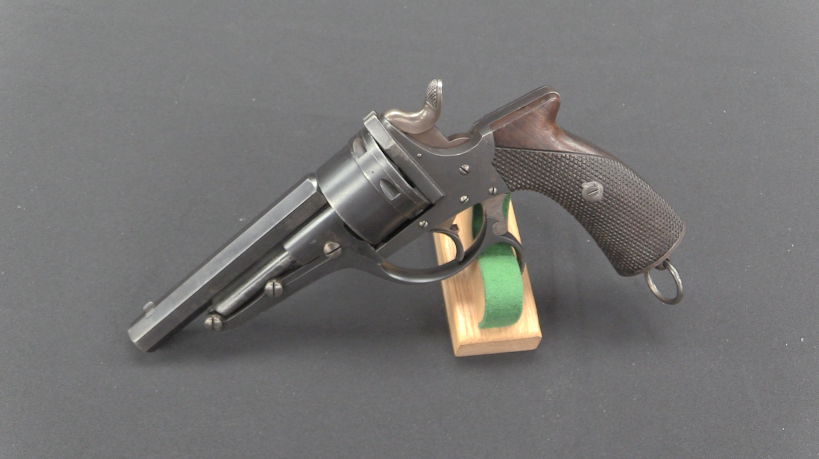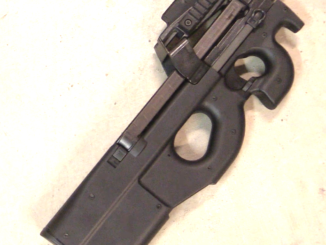Colette was a Belgian gun manufacturer that made this interesting parlor pistol. It used a rocketball type of cartridge, in which the powder and primer were encased in the hollow base of the bullet to make a caseless cartridge. The gravity pistol was named for its gravity feed mechanism and its 20-round capacity. Because of the very limited powder capacity of this type of cartridge, these pistols were made solely for sporting and recreational use, without an attempt at military adoption.
Related Articles

Revolver
RIA: Russian M1870 Galand Revolver (Video)
The Galand was an innovative revolver design created by Frenchman Charles Francois Galand and patented in 1868. It is most notable for using a long lever system to eject cartridges by throwing the cylinder and […]

Submachine Guns
P90: FN’s Bullpup PDW
FN began developing the P90 in the late 1980s, actually preceding the NATO requirement that it would eventually compete for. The idea of the P90 was to develop a weapon for secondary troops to replace […]

Light MGs
FN Model D (BAR)
The FN Model D was the most fully developed variant of the venerable Browning Automatic Rifle. Introduced in 1932 by Fabrique Nationale (with whom Browning had collaborated extensively prior to his death in 1926), the […]

How can the shooter extract misfire cartridge or unloading un-fired cartridge before gun storage/cleaning? There is no extractor…
There is no cartridge, therefore nothing to extract and eject. The bullet holds the powder and primer. Wonder how it would work with the right smokeless powder?
Very badly for the chamber, unless you did it correctly.
As with the Volcanic, a dud round pretty much stonewalls the whole operation. I imagine that the only way to deal with it would be to invert it, open the breech, and use a rod (cleaning/ram/stick/etc.) to knock the dud out.
And if your dud turned out to be a hangfire…oops. It goes BANG in the open at your feet.
In their own time these arms were sometimes known as “drop pistols”, due to the movements of the hand necessary to reload them. The main reason they never became popular was that, like the Volcanic, by the time they showed up, Colt’s, LeFaucheux’, and Adams’ perfected revolvers had been on the market for over a decade. (Nearly two in Colt’s case, going back to the 1836 Paterson Model.)
They simply couldn’t compete with the revolvers for reliability, sturdiness, safety, and hitting power. Accuracy-wise, the revolvers generally won, as well.
As for “tactical” use, it wouldn’t take much imagination to visualize what would happen if you got into a fight with someone wielding a Colt or Adams .36 or .44 or (in the Adams’ case) .50 revolver with one of these in your hand. While you were performing the legerdemain necessary to fire a second shot, the opponent has probably already put six of the best through you, especially with the double-action Adams.
Not exactly a desirable outcome.
cheers
eon
Given a choice, I would have brought a Berger pistol (maybe) to a fight with an Adams revolver. The Schuler Reform pistol also deserves a mention, being less finicky than the Gravity Pistol… Or am I wrong?
Keep in mind that the Berger is a lever-operated manual repeater, and dates to 1881. The Reform, designed for Schuler by August Menz, dates to the late 1890s. So they wouldn’t be around for 30 to 40 years later, by which time the revolver has graduated to the self-contained metallic cartridge, too.
The nearest thing to the Reform-type available in the 1850s would have been the early (and rare) percussion version of the Marston metallic-cartridge three-barrel pistol;
http://www.rockislandauction.com/viewitem/aid/57/lid/40
Or the circa 1860 Jones patent ten-barrel pistol;
http://www.collectorebooks.com/gregg01/Lot-109.htm
Either one of which could mess someone up pretty thoroughly. But like the pepperbox they were (more or less) related to, both were heavier, bulkier, and more unwieldy than a comparable-bore revolver. The Jones patent gun at least had the virtue of a double-action trigger.
The Marston’s main claim to fame is that like the Moore all-metal derringer, it apparently began in the late 1850s as a percussion design but by the time it went into production around 1861-62, it had been “modernized” into metallic-cartridge form in .22 and .32 rimfire.
Myself, I’d stick to a pair of Adams or better yet Beaumont-Adams revolvers, preferably in 58-bore (.430 in, aka “.44 caliber”). Six DA shots plus a lightning-fast reload, by simply removing the empty cylinder and replacing it with a loaded one, similar to the same procedure with the Remington 1860-series single-action revolvers. (See the Clint Eastwood movie Pale Rider to watch this drill being used.)
The B/A and Remington revolvers even in the percussion era could be reloaded very nearly as quickly as a modern self-loading pistol with a detachable box magazine. This gave them a fearsome firepower advantage in their own time, an still makes them pretty serious fighting handguns today.
A modern B/A repro loaded with Hodgden WhiteHot pellets and Thompson-Center Cheap Shot sabot or Traditions Plinker 240-grain LHPs would be highly interesting as a short-range defensive pistol.
cheers
eon
It was supposed to be a recreational gun, clearing a dud would be inconvenient, not deadly. It would be interesting to know if these were intended for individual owners or for people to set up shooting galleries.
Shooting galleries used to be very popular, in the earlier part of the last century they might consist of several Remington model 12 pump 22’s. Hard to imagine today, but kids and anyone else with money were handed a loaded repeater at the county fair. There were articles in Popular Mechanics back then on how to best clean the rifles (that saw tremendous use). One suggestion was attaching a wire bore-brush to a brace-and-bit to scrub the bores.
Clever, beautiful pistol.
Great to see you reviewing this, it caught my eye when I checked out the catalog. If only I had $4K or so to spend on something like that.
Speaking of caseless, I was surprised recently to see online that there are quite a few Daisy VL .22s floating around the used/ affordable-collectable market. I remember seeing them in Gun Digest and such when I was a kid (early 70s) and seem to recall that they had about the power of a .22 short. Didn’t know until recently that the reason they disappeared from the market/ never underwent further development was that the ATF had ruled that they were firearms, not air guns and Daisy didn’t have the appropriate license to make “real” guns that used a caseless cartridge. Might make for an interesting Forgotten Weapon if Ian stumbles across one. Also seem to recall that S&W also experimented with a caseless 9mm version of the model 76 copy of the “Swedish K” submachine gun in the late 60s but never brought it to market.
Yes they did. The 9mm caseless round as virtually a scaled up .22 Daisy VL type, with a cylindrical “plug” of propellant glued to the back end of a 9mm FMJ RN bullet.
Ignition was electric, fed by a battery pack under the receiver. The major problems with it were the same as most caseless weapon projects, namely that the caseless rounds were susceptible to changes in temperature and humidity, as well as being less resistant to rough handling that conventional cased ammunition.
Also, as the battery on the gun discharged, after about two magazines’ worth, it no longer had enough amperage for reliable ignition.
the caseless gun and ammunition are still not with us, forty-plus years later. Personally, I suspect that we’ll have gaussrifles and infantry laser IWs before they get the bugs out of caseless ammunition.
cheers
eon
” The gravity pistol was named for its gravity feed mechanism ”
this pistol can’t work in a space shuttle 🙁
“this pistol can’t work in a space shuttle” –Unless you add one (1) compression spring after filling the magazine. You’d lose some ammunition capacity, of course. And the Russians will still have either ТП-82 “space guns” or their standard mil-issue sidearms. (ГШ-18?) Might be better off trying arm-wresting instead.